This project was full of loops and turns like our original Tour De France theme. However, as you can see the theme of the project has taken a slight shift to soccer as we had to adapt and grow while finishing the project, and so did our theme to fit our needs. The project originally involved spinning bikers and a trophy that would come apart and go back together horizontally. However, we realized the many issues that came with that considering size constraints, complexity issues, and too many moving parts. After our first iteration with the cardboard, we decided to scale down the project and move to SolidWorks to model our project confirm our movement worked, and see how to best construct the mechanism.
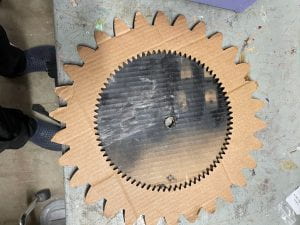
Figure 1: Driven Gear Low Fidelity
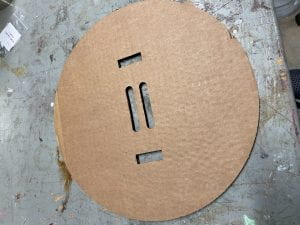
Figure 2: Top Plate Low Fidelty
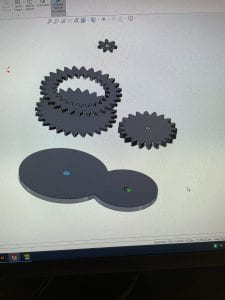
Figure 3: SolidWorks Model
Once we refined the SolidWorks model and confirmed our ideas we moved on to our Medium Fidelity Prototype and decided to start cutting out the wood. The cross mechanism, which is mechanical movement 93 was the most important thing to figure out and get working. The mechanism would convert the rotational movement of the gears to translation movement, which is what we wanted for the dowels. For the medium fidelity prototype, we decided to scrap the idea of the bikers going around in a circle and try to get one to spin, but that failed due to spacing and the gear failing to rotate. The cross mechanism had many iterations and size changes for it to work and properly slide across the support handles.

Figure 3: Medium Fidelity Cross
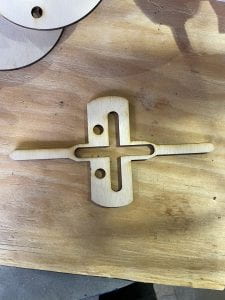
Figure 4: High Fidelity Cross
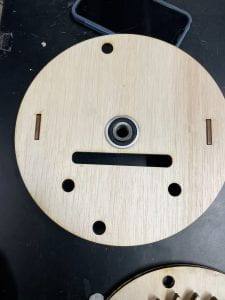
Figure 5: Medium Fidelity Iteration of Top Plate
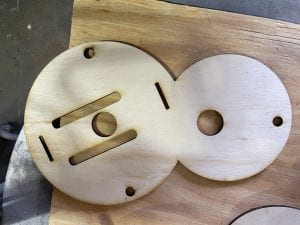
Figure 6: High Fidelity of Top Plate
The medium fidelity cross was successful, but didn’t work as well as we wanted it and didn’t translate enough of the rotational motion to translation motion, because of the curved ends and the straight ends being too small. For the high-fidelity cross mechanism, we decided to add slants instead of making it curved, so it could so further down the cross and to elongate the ends to give it more freedom to move. Finally, we added a circle, so both sides of the cross can have translation movement instead of one since we got rid of some of the other components for simplicity. For the High Fidelity top plate, we decided to add an extra circle to give it more of an aesthetic finish, so the driven gear would be covered and you would only see the top plate and the dowels moving.
The gears for the project stayed the same throughout the medium and high fidelity portions of the project. From the low to medium fidelity we decided to reduce the size and number of teeth of the gears, but that was the main difference. As you can see below we decreased the size of both the driven and driver gear. The handles on top of the driver gear support the cross and give it a pathway for it to move back and forth and stay steady without rocking or falling down. The bearings allow for free rotation through the mechanism where direct rotation from the crank isn’t required and prevents friction and wear from building up. The dowels are all cut to size to help act as supports for the top plate and allow for the movements of the decorative pieces on top.

Figure 7: Parts of the mechanism
07DF7152-3E7D-4209-929F-6B43ECBF850F
Figure 8: Video of the mechanical model
Cost:
Labor – $18/hr for 30 hrs = $480
Materials – $1.16 for plywood – 5 sheets: $5.80
Machines – $600 ($150/hr for laser cutter, 4 hrs)
Tools – $100
Extras (Tape, sandpaper, wood glue, etc.) – $75
Total: $1260.80
